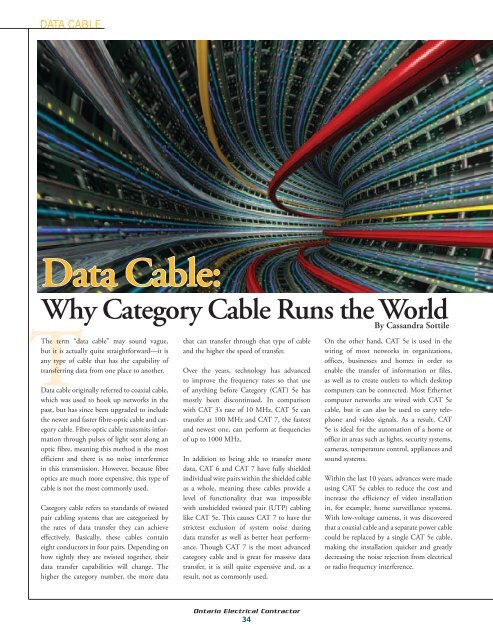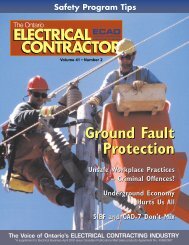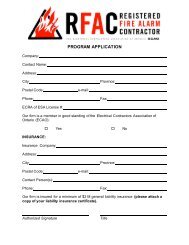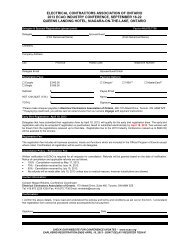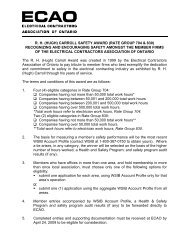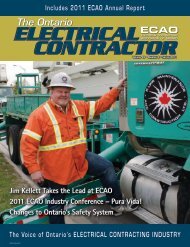Prompt Payment Legislation - Electrical Contractors Association of ...
Prompt Payment Legislation - Electrical Contractors Association of ...
Prompt Payment Legislation - Electrical Contractors Association of ...
- No tags were found...
Create successful ePaper yourself
Turn your PDF publications into a flip-book with our unique Google optimized e-Paper software.
Data CableData Cable:By Cassandra SottileWhy Category Cable Runs the WorldBy Cassandra SottileThe term “data cable” may sound vague,but it is actually quite straightforward—it isany type <strong>of</strong> cable that has the capability <strong>of</strong>transferring data from one place to another.Data cable originally referred to coaxial cable,which was used to hook up networks in thepast, but has since been upgraded to includethe newer and faster fibre-optic cable and categorycable. Fibre-optic cable transmits informationthrough pulses <strong>of</strong> light sent along anoptic fibre, meaning this method is the mostefficient and there is no noise interferencein this transmission. However, because fibreoptics are much more expensive, this type <strong>of</strong>cable is not the most commonly used.Category cable refers to standards <strong>of</strong> twistedpair cabling systems that are categorized bythe rates <strong>of</strong> data transfer they can achieveeffectively. Basically, these cables containeight conductors in four pairs. Depending onhow tightly they are twisted together, theirdata transfer capabilities will change. Thehigher the category number, the more datathat can transfer through that type <strong>of</strong> cableand the higher the speed <strong>of</strong> transfer.Over the years, technology has advancedto improve the frequency rates so that use<strong>of</strong> anything before Category (CAT) 5e hasmostly been discontinued. In comparisonwith CAT 3’s rate <strong>of</strong> 10 MHz, CAT 5e cantransfer at 100 MHz and CAT 7, the fastestand newest one, can perform at frequencies<strong>of</strong> up to 1000 MHz.In addition to being able to transfer moredata, CAT 6 and CAT 7 have fully shieldedindividual wire pairs within the shielded cableas a whole, meaning these cables provide alevel <strong>of</strong> functionality that was impossiblewith unshielded twisted pair (UTP) cablinglike CAT 5e. This causes CAT 7 to have thestrictest exclusion <strong>of</strong> system noise duringdata transfer as well as better heat performance.Though CAT 7 is the most advancedcategory cable and is great for massive datatransfer, it is still quite expensive and, as aresult, not as commonly used.On the other hand, CAT 5e is used in thewiring <strong>of</strong> most networks in organizations,<strong>of</strong>fices, businesses and homes in order toenable the transfer <strong>of</strong> information or files,as well as to create outlets to which desktopcomputers can be connected. Most Ethernetcomputer networks are wired with CAT 5ecable, but it can also be used to carry telephoneand video signals. As a result, CAT5e is ideal for the automation <strong>of</strong> a home or<strong>of</strong>fice in areas such as lights, security systems,cameras, temperature control, appliances andsound systems.Within the last 10 years, advances were madeusing CAT 5e cables to reduce the cost andincrease the efficiency <strong>of</strong> video installationin, for example, home surveillance systems.With low-voltage cameras, it was discoveredthat a coaxial cable and a separate power cablecould be replaced by a single CAT 5e cable,making the installation quicker and greatlydecreasing the noise rejection from electricalor radio frequency interference.Ontario <strong>Electrical</strong> Contractor34


